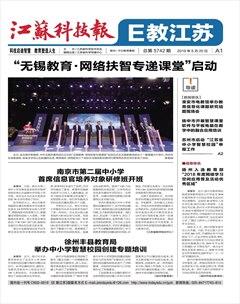CHARTING A COURSE FOR SUCCESS: AMERICA’S STRATEGY FOR STEM EDUCATION(Ⅲ)
【譯题】制定成功之路:美国STEM教育战略(三)
Product of the COMMITTEE ON STEM EDUCATION of the NATIONAL SCIENCE & TECHNOLOGY COUNCIL
美国国家科学技术委员会STEM教育委员会
Pathways to Success(Ⅰ)
Develop and Enrich Strategic Partnerships
America will benefit from strategic partnerships that align what is taught and learned with what is needed at work and in the community. Cross-sector strategic partnerships are needed that better connect educational entities, employers, and the broader communities they serve in order to foster communication and better align workforce needs with educational preparation.
There are three objectives under this pathway:
Foster STEM Ecosystems that Unite Communities
STEM ecosystems engage educators and individuals within and outside a formal educational setting, and include, among others, families; school districts; State, local, and Tribal governments; the Federal Government and Federal facilities; libraries; museums and science centers; community colleges, technical schools, and universities; community groups and clubs; foundations and nonprofits; faith- based organizations; and businesses. STEM ecosystems focus on long-term, shared, sustainable, and flexible STEM missions.
Key Federal actions needed to achieve this objective include:
·Establish additional connections between Federal STEM professionals and Federal facilities and local and regional STEM ecosystems to provide additional opportunities for mentorship, educator professional development, curriculum material development, and other community engagement activities. Establish a single, searchable, user-friendly online resource.
·Increase the number of Federal funding opportunities that include STEM ecosystem engagement or development as an award selection criterion.
·Support intramural and extramural research on factors that influence the success of STEM ecosystems and disseminate successful practices.
Increase Work-Based Learning and Training through Educator-Employer Partnerships
Strategic partnerships that promote work-based learning (WBL) experiences offer powerful, relevant ways to ensure that STEM learning is authentic and engaging, and that learners are prepared to succeed in the modern workforce.
Key Federal actions needed to achieve this objective include:
·Expand the availability of high-quality, paid internships and apprenticeships within Federal agencies.
·Increase the use of the flexible hiring authorities provided by the Federal Pathways employment program, expedite the conversion of Pathways employees to competitive service positions, and quickly begin to use the recently expanded direct and expedited hiring authorities, with a focus on creating a more diverse Federal STEM workforce.
·Increase the number of Federal funding opportunities that explicitly include the use of WBL partnerships as an award selection criterion, including opportunities for educators to broaden their skills through WBL outside the classroom.
·Develop new hiring authorities to convert apprentices, interns, postdoctoral fellows, and others participating in WBL programs to full-time, permanent Federal employment.
Blend Successful Practices from Across the Learning Landscape
Education systems that combine high-quality career and technical training with college preparatory curriculum are particularly effective at preparing students for both employment and post-secondary study, especially when training required to obtain industry-recognized credentials is embedded in the coursework.
Federal agencies should continue to support collaborations among core academic and technical educators in both formal and informal learning environments and endeavor to further unite stakeholders from across the learning landscape.
Key Federal actions needed to achieve this objective include:
·Prioritize Federal support for STEM educator “upskilling” and professional development, including CTE and college preparatory teachers and educators working in both formal and informal settings.
·Prioritize research on the most effective approaches for blending successful learning practices across formal and informal and college preparatory and CTE settings.
·Convene stakeholders through webinars, workshops, and other mechanisms to share effective approaches for blending successful learning practices, and to develop guidance for educators on scaling and replicating best practices.
通往成功的道路(一)
發展和丰富战略伙伴关系
美国将从战略伙伴关系中受益,这种关系将教授和学习的内容与工作和社区需要的内容结合起来。美国政府需要建立跨部门战略伙伴关系,更好地将教育实体、雇主和他们所服务的更广泛的社区联系起来,以便促进沟通,更好地将劳动力需求与教育准备相结合。
在此路径之下有三个目标。
培育联结STEM共同体的生态系统
建立涵盖学校、家庭、社区学院、博物馆和科学中心、公共图书馆、企业、基金会和非营利性组织等其他社区资源的STEM生态系统,使学习者能够在课堂内外更好地开展STEM学习。STEM生态系统专注于长期的、共享的、可持续的、灵活的STEM任务。
为了实现这一目标,联邦政府需要:
·在联邦STEM专业人员和联邦机构以及地方和区域STEM生态系统之间建立额外的联系,为指导及教育专业发展、课程材料开发和其他社区参与活动提供额外的机会。建立一个单一的、可搜索的、用户友好的在线资源。
·增加联邦资助机会的数量,将STEM生态系统参与或开发作为奖励选择标准。
·支持关于影响STEM生态系统成功因素的校内和校外研究,并宣传成功的做法。
通过教育—雇主伙伴关系,增加工作本位的学习和培训
工作本位学习能够为学习者提供真实情境的任务,寻找解决问题的方法,从而使STEM学习更真实、更具有吸引力,而且也使得学习者能够更好地为将来就业做准备。
为了实现这一目标,联邦政府需要:
·通过资助项目,提供高质量、带薪学习和学徒制的机会。
·增加使用联邦通道就业计划提供的灵活的招聘权限,加快通道员工向竞争性服务职位的转换,并迅速开始使用最近扩大的直接和快速招聘权限,重点是创建更加多样化的联邦STEM员工队伍。
·政府将聘用更多服务于工作本位学习项目的师资和研究人员,为其提供保障、增加对其奖励和资助等,包括教育工作者在课堂外通过工作本位学习拓展技能的机会。
·发展新的招聘机构,将学徒、实习生、博士后研究员和其他参与本位学习项目的人转变为全职、永久的联邦雇员。
分享并融合成功的STEM教育实践经验
将高质量的职业技术培训与大学课程结合起来,特别是将行业证书考核的内容嵌入到课程中,可以有效地帮助学习者为未来就业做好准备。
联邦机构应继续支持核心学术和技术教育者在正式和非正式学习环境中的合作,并努力进一步团结学习领域的利益相关者。
为了实现这一目标,联邦政府需要:
·优先考虑联邦对STEM教育工作者“升级”和专业发展的支持,包括在正式和非正式环境中工作的科技教育学校、大学预备教师和教育工作者。
·优先研究最有效的方法,在正式和非正式以及大学预科和科技教育学校环境中融合成功的学习实践。
·通过网络研讨会、讲习班和其他机制召集利益攸关方,分享融合成功学习实践的有效方法,并为教育工作者制定推广和复制最佳实践的指南。

